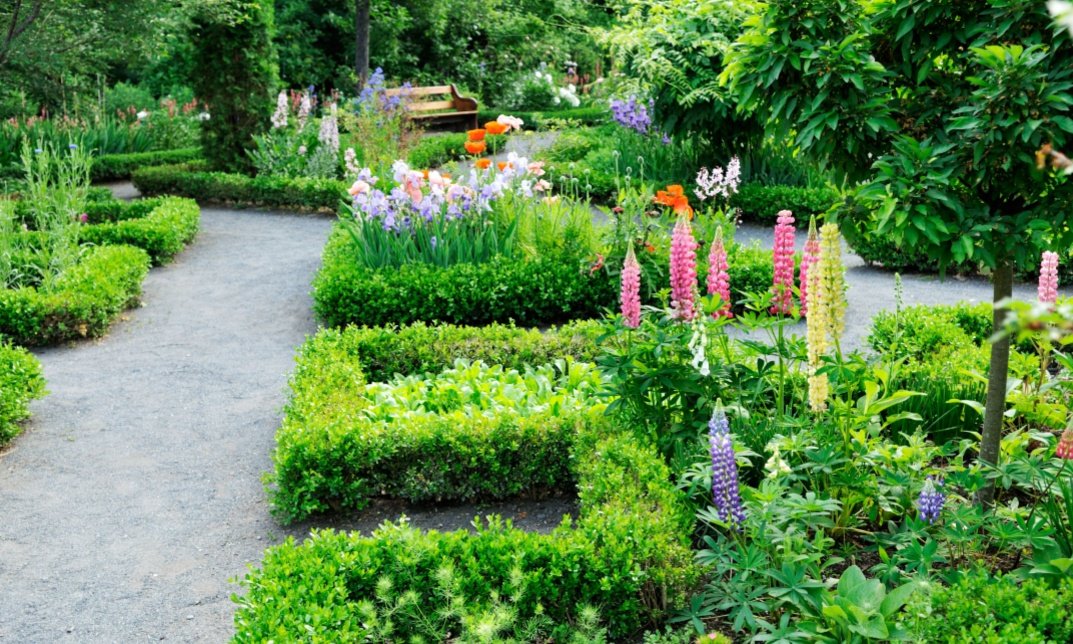No products in the cart.
Do you dream of a garden that looks great all year round? And, requires little upkeep and has a mix of natural textures? If so, garden design with sleepers and gravel could be exactly what you need. This approach combines the warm tones of wood with the neatness of gravel, creating a stylish and practical outdoor space that’s both timeless and easy to maintain. So, let’s explore how to make this vision a reality and cover everything you need to know to design a garden that’s inviting.

What Are Sleepers and Gravel?
Sleepers, traditionally made of wood, are thick, solid planks originally designed for railway tracks. Now widely used in landscaping, wooden sleepers bring warmth and a natural, earthy tone to garden spaces. It also provides a strong structure for paths, raised beds, and garden borders. Moreover, sleepers are available in different finishes and are sometimes treated to resist rot. Additionally, they are long-lasting and can be used in various ways to shape a garden’s layout.
Gravel, on the other hand, is a group of small stones that are ideal for garden surfaces due to their excellent drainage and low maintenance requirements. And there are many sizes and colours. Starting from smooth pea gravel to thicker rocks. As a result, you can match them to your garden style. Gravel is a low maintenance material that prevents water buildup. Therefore suitable for walkways and areas around trees.
Benefits of Garden Design with Sleepers and Gravel
Choosing sleepers and gravel offers practical and aesthetic benefits. So, here are some of the reasons why these materials are a popular choice:
- Low Maintenance: Gravel doesn’t need mowing or trimming, making it easy to care for. Moreover, sleepers, especially treated ones, are durable and require minimal upkeep.
- Good Drainage: Gravel allows water to drain freely, preventing puddles from forming. As a result, this helps protect plants by avoiding waterlogged soil and root rot.
- Cost-Effective: Sleepers and gravel are more affordable than many other paving options. Additionally, they allow you to create a stylish garden without spending too much.
- Versatile Style: This design suits modern, rustic, and classic garden styles. Therefore, it’s a flexible choice that can adapt to various aesthetic preferences.
- Durable and Hard-Wearing: Both materials are strong and built to last. As a result, they can withstand harsh weather, ensuring your garden stays beautiful for years.
Steps To Get Started: Planning Your Layout
Drawing a preliminary layout on paper will help you decide where to put sleepers and gravel. So, here are some planning suggestions to get you started:
- Define Key Areas: Creating separate sections can give your garden a clear structure and purpose. Therefore, think about what areas you’d like to feature, such as walkways, seating zones, or flower beds.
- Choose the Shape: Garden design with sleepers and gravel works for both; you could have straight sleeper paths or curved edges with gravel in between. Thus, decide if you prefer straight lines for a modern look or curves for a softer, more natural feel.
- Consider Material Colours: Decide if you want natural, untreated wood sleepers for a rustic feel or treated ones for a longer-lasting look. When choosing gravel, lighter colours brighten up a garden, while darker shades provide a dramatic effect.
Garden Design Ideas with Sleepers and Gravel
For some inspiration, here are a few creative ideas to elevate your garden:
- Meditation Corner: Create a quiet space with a seating area surrounded by gravel and raised beds. Place a sleeper bench or seating, allowing you to sit and enjoy the surroundings.
- Herb Garden: Use sleepers to build raised beds specifically for herbs. Position them near your kitchen door for easy access.
- Water Feature with Gravel Base: A small water feature over a gravel bed can soothe your garden. The contrast between water, wood, and gravel is visually calming.
- Rustic Fire Pit Area: For evening gatherings, create a fire pit area with sleepers as benches and a gravel floor. This area is easy to maintain and gives a natural charm to your garden.
- Layered Planting Beds: Build tiered beds with sleepers, planting a mix of tall and short plants for a varied look. Use gravel to fill in the spaces between beds.
Building with Sleepers
Once your layout is ready, it’s time to set up the sleepers. Here’s how you can use sleepers in different parts of your garden.
Pathways
Creating pathways is one of the most popular ways to use sleepers. Lay them down horizontally in a step pattern or arrange them vertically to define a path. When paired with gravel, sleeper pathways offer both a natural and practical look. So, here are a few tips:
- Level the Ground: Before placing sleepers, make sure the ground is even. This helps keep them stable and reduces the risk of tripping.
- Add Gravel Between Sleepers: For an interesting look, place gravel between each sleeper, allowing a mix of wood and stone to guide you along the path.
- Secure the Sleepers: You may need to anchor the sleepers to prevent movement, especially if they’re laid on a slope.
Raised Beds
Sleepers work excellently as walls for raised beds, giving your plants better drainage and making it easier for you to manage them. Moreover, raised beds are visually appealing and give structure to your garden.
- Stack the Sleepers: Lay sleepers on top of each other to create walls for the bed. Secure each layer with screws to ensure stability.
- Line the Inside: Use a liner to protect the wood from rot. This is especially important if you’re using untreated sleepers.
- Add Gravel Around the Beds: Placing gravel around raised beds not only looks neat but also reduces weeds.
Edging and Borders
Sleepers are ideal for defining garden edges adding a clear boundary between flower beds, lawns, and pathways. Edging with sleepers prevents soil from spilling onto paths and gives a polished look.
- Half-Sunk Sleepers: For a lower-profile border, sink half of each sleeper into the ground.
- Paint or Stain: If you want your garden design with sleepers and gravel to have a more contemporary feel, consider staining or painting the sleepers to match other garden features.

Laying the Gravel
Gravel doesn’t just act as a filler; it adds texture and a sense of unity to your garden. Here’s how to make the most of it.
- Choose the Right Gravel Type: Each gravel type serves a different purpose. Small pea gravel is soft underfoot, making it perfect for walks and seating spaces. On the other hand, larger gravel or crushed stone is suitable as a base layer or decorative element.
- Prepare the Base: Before spreading the gravel, lay a weed-suppressing membrane on the soil. This helps to prevent weeds from popping up and keeps the gravel in place. Then, add a layer of crushed stone as a base before placing the gravel on top.
- Spread the Gravel Evenly: Use a rake to spread the gravel to the desired depth, which is usually about 5 cm for paths. Consider a thicker layer for areas with heavier foot traffic to ensure durability.
Conclusion
Designing a garden with sleepers and gravel is a simple solution. However, it’s effective in transforming your outdoor space. This style works well with any size of garden. It combines wood and stone in a way that feels rustic and modern. Also, don’t forget to plan carefully, choosing materials and colours that match your vision. With a little time and creativity, your garden will become an attractive and welcoming place where you will love spending time.
So, are you ready to transform your outdoor space into a stunning work of art? Join Wise Campus’s landscape gardening course and discover the skills to design and create functional gardens that are inspiring and stunning!







